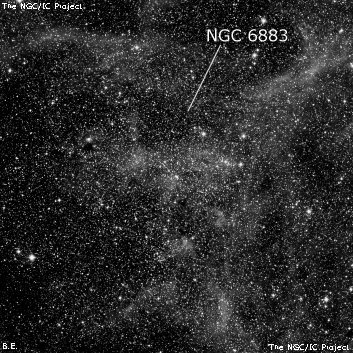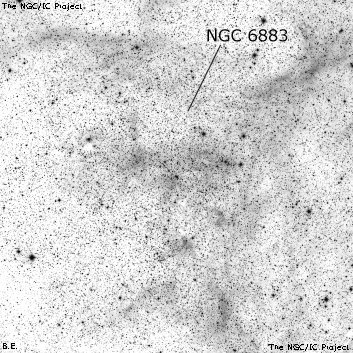NGC/IC Project Restoration Effort
(This is a very very beta version)
NGC6883


Basic Information
Location and Magnitude
Right Ascension: 20:11:18.0
Declination: +35:51:0
Constellation: CYG
Visual Magnitude: 8.0
Historic Information
Discoverer: Herschel J.
Year of discovery: 1828
Discovery aperture: 18.3
Observational
Summary description: Cl, pRi, ** inv
Sub-type: I3p
Corwin's Notes
=====
NGC 6883. JH found this ill-defined cluster on 19 August 1828, giving it the
position of a bright double star towards its southeastern edge. He says only,
"A double * in a cluster of a good many stars 10 ... 13 m ...", so we have no
idea of its perceived diameter. It is immersed in the Milky Way, so the field
is rich. There is also whispy emission nebulosity here; its extent -- as well
as that of the cluster itself -- seems to be defined by the absorption patches
scattered across the field.
The grouping that I've picked out more or less matches JH's description -- but
I certainly wish he'd given us some idea of the cluster's size.
Steve's Notes
=====
NGC 6883
18" (10/8/05): at 115x, 60 stars over haze are visible in a 6' group that is set in an incredibly rich Milky Way field. Five of the brighter stars on the south side form an elongated "Y" or "Wishbone" asterism with a bright pair of mag 9.5/10 stars (17" separation) at the base of the wishbone. The west side of the cluster is defined by a gently curving string of 10 faint stars. At 220x, up to 80-90 stars can be counted in an 7'x5' region as a number of faint stars emerge from the background. At low power this region is surrounded by other concentrations or asterisms including Ruprecht 172, which spreads out to the southeast. About 30' NW is the WR 134/135 Nebula, an uncatalogued but relatively bright Wolf-Rayet shell nebula.
17.5" (8/19/95): two dozen stars in a 4' diameter surrounding a prominent "Y" asterism of five mag 10 stars with twenty additional mag 13-14.5 stars. The brightest star at the base of the "Y" is a mag 9.5/10 double at 17" and the center star about 1.5' NE is an unequal closer pair. Surrounding this group is a oval border of 7' diameter consisting of several strings of mag 13 stars, which increase the total to roughly 50 stars. Appears to be an asterism in a rich Milky Way field and best view at 100x. Attached to Ruprecht 172.
8" (8/15/82): elongated string of stars N-S, moderately large, over background haze. Situated in a very rich star field and difficult to identify.



